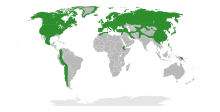Saxifragaceae
| Saxifragaceae | |
|---|---|

| |
| Tiarella (Foamflower) | |
| Scientific classification | |
| Kingdom: | Plantae |
| Clade: | Tracheophytes |
| Clade: | Angiosperms |
| Clade: | Eudicots |
| Order: | Saxifragales |
| Family: | Saxifragaceae Juss. |
| Type genus | |
| Saxifraga | |
| Clades | |
|
See text | |

| |
| The range of Saxifragaceae | |


Saxifragaceae is a family of
Description
This section may be too technical for most readers to understand. (August 2020) |
Species are
The inflorescences are bracteate racemes or cymes. The flowers are hermaphroditic (bisexual), rarely unisexual (androdioecious), actinomorphic (rarely zygomorphic). The perianth is placed on a hypanthium that may be free or may be partly fused with the ovary (which is then semi-inferior). There are usually five sepals, but there may be three to ten, fused with the hypanthium, occasionally petaloid. The petals are clawed, sometimes cleft at the tip or finely dissected. Flowers have five to ten stamens, free and opposite the petals, with the anthers usually basifixed and opening by lengthwise slits. The ovary is inferior to semi-inferior with two (sometimes three) carpels usually fused at the base, sometimes free, each topped with stylodium and capitate stigma. The ovules are few to many, with axile or parietal placentation and two to three styles. The fruit is usually a septicidal capsule or follicle, with numerous small seeds.[1][2]
Taxonomy
Saxifragaceae has long been considered in a pivotal position in the evolution of angiosperm lineage, located in an ancestral "Saxifragalean stock". Historically the Saxifragaceae have included many very
The circumscription of the family has changed considerably in recent years, in large part due to
The reduced Saxifragaceae is distinguished by being referred to as Saxifragaceae sensu stricto (s.s.), corresponding to the Saxifragoideae a natural monophyletic group.
| Cladogram I: Saxifragales families[9][10][6] | ||||||||||||||||||||||||||||||||||||||||||||||||||||||||||||||||||||||||||||||||||||
| ||||||||||||||||||||||||||||||||||||||||||||||||||||||||||||||||||||||||||||||||||||
| 100% maximum likelihood bootstrap support except where labeled with bootstrap percentage (Cynomoriaceae) remains unplaced within this tree
Monogeneric families are represented by genus names, otherwise the number of genera is in (parentheses) Cynomorium |
Subdivision



Numerous attempts have been made to subdivide Saxifragoideae (Saxifragaceae s.s.). These have included dividing the family by the placentation of the ovules, as either parietal (e.g. Heuchera) or axile (e.g. Saxifraga). None of these has been supported by molecular data.[1][7]
- Clades (Genera (Species))
- Saxifragoids (Saxifraga (370))
- Heucheroids (remaining genera):
- Leptarrhena (Leptarrhena (1), Tanakaea (1))
- Saniculiphyllum (Saniculiphyllum (1))
- Boykinia ( (2))
- Astilbe (Astilbe (23), Saxifragopsis (1))
- Heuchera (Heuchera (36), Bensoniella (1), Conimitella (1), Elmera (1), Lithophragma (10), Mitella (20), Tellima (1), Tiarella (3), Tolmiea (1))
- Cascadia (Cascadia (1), Saxifragodes (1))
- Darmera (Darmera (1), Astilboides (1), Bergenia (10), Mukdenia (1), Oresitrophe (1), Rodgersia (5))
- Peltoboykinia (Peltoboykinia (1), Chrysosplenium (55))
- Micranthes (Micranthes (70))
The clades and subclades are related as shown in the cladogram:[8]
| Cladogram II: Infrafamilial structure of Saxifragaceae | |||||||||||||||||||||||||||||||||||||||||||||||||||||||||||||||
| |||||||||||||||||||||||||||||||||||||||||||||||||||||||||||||||
| Diversification time in Mya underneath group names |
Genera
Saxifragaceae s.s. has about 33–35 genera and about 640 species. About half of the genera (18 of 33) are
Evolution and biogeography
The
Etymology
The family and type genus name are derived from the two Latin words saxum (rock), and frango (to break), but the exact origin is unknown, although surmised to refer to either growing in crevices in rocks or medicinal use for
Distribution and habitat
Primarily Northern hemisphere temperate and arctic regions, and also tropical montane, including the Americas, Europe, North Africa (including montane Ethiopia) and temperate and subtropical Asia to
References
- ^ a b c d e Byng 2014.
- ^ a b c d e Christenhusz et al 2017.
- ^ a b Schulze-Menz 1964.
- ^ a b c Morgan & Soltis 1993.
- ^ Soltis & Soltis 1997.
- ^ a b c APG IV 2016.
- ^ a b c d Soltis et al 1993.
- ^ a b c d e f Deng et al 2015.
- ^ Jian et al 2008.
- ^ Stevens 2019.
- ^ Christenhusz & Byng 2016.
Bibliography
Books
- ISBN 978-0-9929993-1-5.
- ISBN 978-0-226-52292-0.
- ISBN 978-3-540-32219-1.
- Soltis, D E (2007). Saxifragaceae. pp. 418–435., in Kubitzki (2007)
- Schulze-Menz, G K (1964). "Saxifragaceae". In Gebrüder Borntraeger Verlag. pp. 201–206. (see also Syllabus der Pflanzenfamilien)
Articles
- .
- .
- Deng, Jia-bin; Drew, Bryan T.; Mavrodiev, Evgeny V.; Gitzendanner, Matthew A.; PMID 25479063.
- Jian, Shuguang; PMID 18275001.
- Morgan, David R.; JSTOR 2399851.
- PMID 21708603.
- JSTOR 2445753.
Websites
- Stevens, P.F. (2019) [2001]. "Saxifragales". AP Web v. 14. Missouri Botanical Garden. Retrieved 25 September 2019. (see also Angiosperm Phylogeny Website)
- POWO (2019). "Saxifragaceae Juss". Plants of the World Online. Royal Botanic Gardens, Kew. Retrieved 1 December 2019.
External links
 Media related to Saxifragaceae at Wikimedia Commons
Media related to Saxifragaceae at Wikimedia Commons- . Encyclopædia Britannica. Vol. 24 (11th ed.). 1911.
- Saxifragaceae in Topwalks
